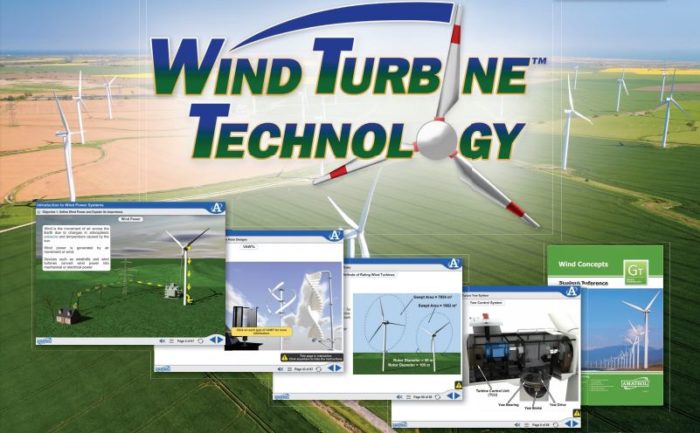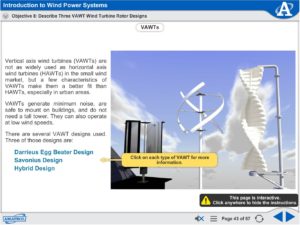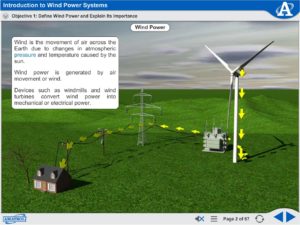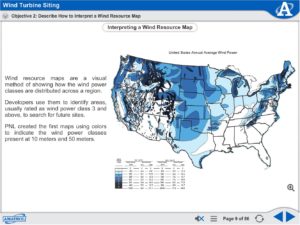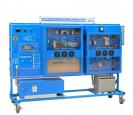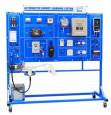Wind Concepts Learning System
Wind energy is a significant source of power that is growing dramatically. The Department of Energy has set a goal for 20% of electrical energy used in the United States to be from wind power by 2030. Wind farms can be found throughout the world – from cold, arctic conditions to the tropics, from beaches to mountains to oceans. Understanding the basics of how wind energy is harnessed will prepare technicians, engineers, installers, designers, builders, and others that want to utilize wind technology in either large utility-scale turbine farms or small wind applications.
Amatrol’s Wind Concepts Learning System (950-WC1) introduces learners to a broad range of basic concepts in wind energy technology. Learners study how wind power systems work and what it takes to generate electrical power with wind. Wind Concepts training acts as a foundation for learners enrolled in wind-specific as well as general renewable energy programs.
Using Wind Technology to Capture Wind Energy
Siting a wind farm or turbine is vital. Utility-scale wind turbines cost several million dollars and the wind available at different heights varies tremendously, so understanding how much energy you can produce from the turbine in a specific location is imperative. With Wind Concepts training, learners gain knowledge and skills in applying science and mathematical skills to the variables involved in the critical turbine siting decision.
The Many Types of Wind Power Systems
Wind power is harnessed by a broad array of wind power systems. The most striking difference is between residential or small wind and utility-scale turbines. While each have their place in the energy landscape, they are very different in both application and design. Understanding the fundamentals of these various systems and how they are used is a good base from which to launch a strong knowledge of wind power. Amatrol’s Wind Concepts training system teaches learners about the range of wind power systems and how they are applied.
Multimedia Curriculum
Amatrol’s unmatched multimedia utilizes text, audio, and stunning 3D animations that engage learners in both theoretical knowledge and hands-on skills. This thorough, exceptionally detailed curriculum is built to begin with the basics and steadily advance to more complex concepts and skills. Through partnerships with key industry leaders and leading-edge educators, Amatrol developed the perfect balance of knowledge and applied skills needed to train learners to work in their chosen field.
Student Reference Guide
A sample copy of this course’s Student Reference Guide is included with the learning system. Sourced from the multimedia curriculum, the Student Reference Guide takes the entire series’ technical content contained in the learning objectives and combines them into one perfectly-bound book. If you would like to inquire about purchasing additional Student Reference Guides for your program, contact your local Amatrol Representative for more information.
Learning Topics
- Wind Resources
- Wind Resource Measurement
- Wind Power Systems
- Utility-Scale Wind Power Systems
- Wind Power Industry
- Small Wind Power Systems
- Wind Turbine Aerodynamics
- Wind Power Characteristics
- Wind Turbine Ratings
- Wind Turbine Capacity & Availability
- Wind Plant Siting
- Wind Plant Economics
Key Features
- Interactive, Engaging Multimedia
- Types of Wind Power Systems
- Wind Technology to Capture Wind Energy
Options
- Solar Thermal Cold Water Supply Station (95-STW1)
- Solar Concepts Learning System (950-SC1)
- Solar Instruments Package (95-SIP) (for outside use)
Requirements
- Computer: See requirements
More Information
Wind Concepts eLearning
Wind Energy & Technology Training
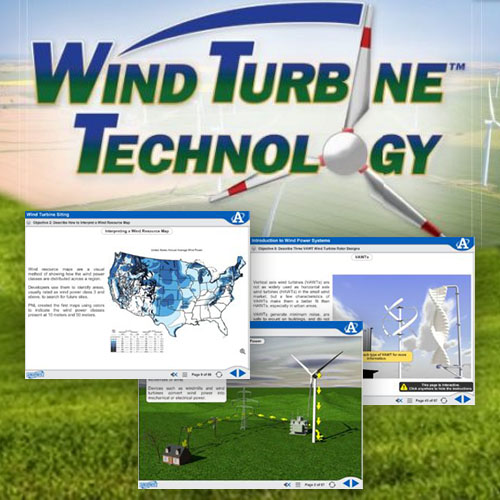 Wind Concepts eLearning (M20011) introduces wind energy as an important source of power that is growing dramatically. Wind farms can be found in virtually all areas – from cold, arctic conditions to the tropics. Wind concepts provides learners an understanding of the basics of how we can harness wind energy, either in large utility-scale turbine farms or in small wind applications. Amatrol’s Wind Concepts eLearning provides an overview of a broad range of basic concepts in wind energy and technology including how wind power systems work and what it takes to generate power with wind technology.
Wind Concepts eLearning (M20011) introduces wind energy as an important source of power that is growing dramatically. Wind farms can be found in virtually all areas – from cold, arctic conditions to the tropics. Wind concepts provides learners an understanding of the basics of how we can harness wind energy, either in large utility-scale turbine farms or in small wind applications. Amatrol’s Wind Concepts eLearning provides an overview of a broad range of basic concepts in wind energy and technology including how wind power systems work and what it takes to generate power with wind technology.
Engaging Multimedia
Amatrol’s extensive, thorough multimedia covers green energy basics such as wind concepts. Interactive screens paired with instructive graphics teach wind concepts topics from wind power systems to wind turbine siting. Learners can then apply this theoretical knowledge to immediate hands-on skills. For example, learners study wind power characteristics and then on their own calculate the wind turbine power given meteorological conditions for applied practice. This combination of theory and practice ingrains concepts in a learner’s mind and makes more advanced topics easier to comprehend. (References 950-WC1)
Key Features
- Strong Depth and Breadth of Content
- Engaging Interactions
- Stunning 3D Animations
- Text and Audio
- Built for Self-Paced Learning
Agriculture, Food & Natural Resources
![]() Agriculture can be considered one of the oldest industries in th world tracing its origin back 12,000 years. What started with small groups of people in various locations figuring out how to domesticate animals and grow their food has become a multi-trillion-dollar global industry.
Agriculture can be considered one of the oldest industries in th world tracing its origin back 12,000 years. What started with small groups of people in various locations figuring out how to domesticate animals and grow their food has become a multi-trillion-dollar global industry.
Over the last few centuries, sparked by a series of industrial revolutions, significant changes have taken place throughout the industry that has shaped agriculture as we know it today. Machinery has replaced manual processes and hand tools. Additionally, technological advances, including computers and the Internet, have enabled agricultural machines and procedures to be more productive and efficient.
As technology continues to advance, agriculture must keep evolving to ensure that productivity keeps pace with an ever-expanding world population. Today’s agricultural experts need experience with more types of technology than ever before.
Agricultural mechanics is a critical component of robust and relevant agriscience programs. With the right equipment, educators can demonstrate how to construct and repair equipment, buildings, and facilities by following architectural and mechanical plans, show mechanical equipment and power systems, and teach hydraulic and pneumatic systems service and repair.
Plants, farms, and animals are the main functions of agriculture. Still, there are additional opportunities in this field. This career pathway covers a variety of careers - ranging from animal science and veterinary science to metal technologies/welding, oil and gas production systems, and energy & natural resources.
Students need the opportunity to apply physical science principles to their studies with an agricultural mechanics career track that covers:
- Agricultural systems including equipment, power systems, alternative fuel sources and precision technology
- Welding trainers, CNC tables, and hydraulics training systems are all key components to the formula that makes up a robust educational program
- Food Production & Processing Systems
- Natural and Rewable Resource Systems
- Animal Systems, Veterinary Programs

